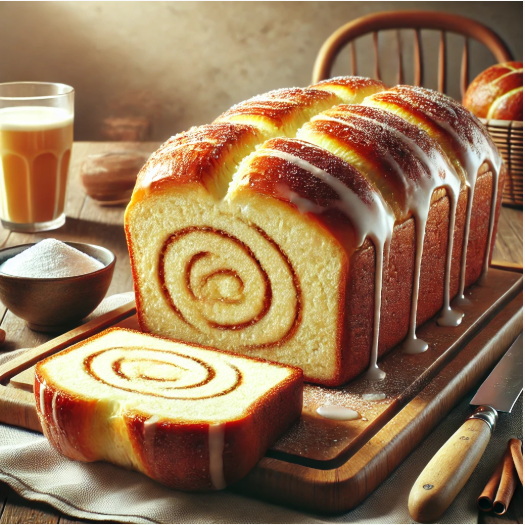Sweet breads are a delightful twist on traditional loaves, offering a soft, rich, and slightly sweet crumb that makes them perfect for breakfast, dessert, or a cozy afternoon treat. From cinnamon swirl breads to chocolate chip loaves and fruity braided breads, these variations are as fun to make as they are to eat.
In this article, you’ll learn how to make sweet breads at home, including key ingredients, helpful techniques, and recipe ideas that are sure to impress your family.
- What Makes a Bread “Sweet”?
Sweet breads typically include a higher amount of sugar, fat, and sometimes eggs and dairy compared to regular artisan or rustic breads. These ingredients contribute to a softer crumb, richer flavor, and beautiful golden crust. They’re similar to enriched doughs and are often used for:
- Cinnamon rolls
- Chocolate babka
- Brioche
- Panettone
- Sweet buns and raisin loaves
Unlike quick breads (like banana or pumpkin bread, which use baking soda or powder), sweet breads still rely on yeast for rising, giving them a chewy, bread-like texture.
- Key Ingredients for Sweet Bread
To master sweet breads, get familiar with the ingredients that give them their soft, rich profile:
- Flour: All-purpose flour works well for sweet breads, offering a tender crumb. Some recipes may include a portion of bread flour for extra structure.
- Yeast: Instant or active dry yeast is typically used. Because sweet doughs rise more slowly due to the higher sugar and fat content, patience is important.
- Sugar: White granulated sugar is most common, but brown sugar, honey, maple syrup, or coconut sugar can add depth.
- Fat: Butter is the gold standard. It adds richness, softness, and flavor. For dairy-free versions, vegetable oil or vegan butter can be used.
- Eggs: Eggs help create a tender structure and golden color. They also contribute richness and moisture.
- Milk: Whole milk or buttermilk enhances the dough’s tenderness. Plant-based milk alternatives can be used if needed.
- Flavorings: Cinnamon, nutmeg, vanilla, citrus zest, dried fruits, and chocolate chips are common additions to enhance flavor and personality.
- The Dough: Mixing and Handling
Sweet bread dough tends to be soft, sticky, and rich due to the sugar and fat. When mixing, it may take longer to develop gluten. A stand mixer with a dough hook is especially helpful, but you can also knead by hand—just expect it to be a little more work.
Mixing tips:
- Mix your dry ingredients first, then slowly incorporate your wet ingredients.
- Add softened butter after the dough has come together—it helps create an even texture.
- If the dough is very sticky, don’t add too much flour. Let it rest (autolyse) and develop naturally as the gluten forms.
Knead until the dough is smooth, elastic, and just slightly tacky.
- The Rise: Take It Slow
Because of the sugar and fat, sweet bread dough often ferments slower than regular dough. You might need to allow extra time during both the bulk rise and the final proofing.
Rising tips:
- Let the dough rise until it has doubled in size. This can take 1.5 to 2.5 hours depending on room temperature.
- If your kitchen is cool, place the dough in a slightly warmed oven (turned off) or use a proofing box.
- A longer rise improves flavor and structure—don’t rush it.
- Shaping Sweet Breads
Sweet breads give you a lot of room for creativity. You can shape them into traditional loaves, rolls, braids, or spirals.
Popular shapes:
- Swirl Loaf: Roll out the dough, add a cinnamon sugar or chocolate filling, and roll it up like a jelly roll before placing it in a loaf pan.
- Braided Bread: Divide dough into three ropes and braid them for a beautiful presentation. Fill with jam, dried fruit, or nut paste for extra flair.
- Buns: Roll small pieces into tight balls and arrange in a pan for pull-apart rolls.
Tip: Brush the shaped dough with egg wash (a mixture of egg and milk) before baking for a shiny, golden crust.
- Baking and Internal Temperature
Sweet breads are typically baked at slightly lower temperatures (325°F to 375°F / 165°C to 190°C) to prevent the sugar from burning too quickly. Bake until the top is golden brown and the internal temperature reaches about 190°F (88°C).
If your bread is browning too fast, cover it loosely with foil during the last part of baking.
- Cooling and Finishing Touches
Let the bread cool for at least 30 minutes before slicing. This helps the interior finish setting and improves texture. Sweet breads are often served plain, but you can also add a drizzle of icing, dusting of powdered sugar, or glaze for a bakery-style finish.
Glaze ideas:
- Vanilla glaze (powdered sugar + milk + vanilla)
- Lemon glaze (powdered sugar + lemon juice + zest)
- Chocolate ganache
- Recipe Ideas to Try at Home
Here are a few sweet bread ideas to experiment with:
- Classic Cinnamon Swirl Bread
- Chocolate Chip Brioche
- Orange Cranberry Holiday Loaf
- Lemon Poppy Seed Yeast Bread
- Nutella Braided Bread
- Vanilla Bean Pull-Apart Rolls
Sweet breads are more than just delicious—they’re a way to bring joy and warmth into your kitchen. Whether you keep it simple or go all out with a filling and glaze, your homemade sweet bread is sure to be a hit with friends and family.
